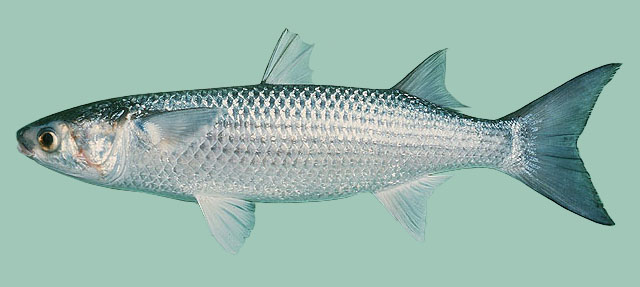| Mugilidae (Mullets) |
| 100 cm SL (male/unsexed); max. reported age: 16 years |
|
benthopelagic; depth range 0 - 120 m, catadromous |
| Cosmopolitan in coastal waters of the tropical, subtropical and temperate zones of all seas. Eastern Pacific: California, USA to Chile (Ref. 2850). Western Pacific: Japan to Australia (Ref. 9812). Western Indian Ocean: from India to South Africa (Ref. 4393). Western Atlantic: Nova Scotia, Canada to Brazil (Ref. 7251); Cape Cod to southern Gulf of Mexico (Ref. 26938); absent in the Bahamas and most of West Indies and Caribbean (Ref. 7251, 9761). Eastern Atlantic: Bay of Biscay to South Africa, including the Mediterranean Sea and Black Sea (Ref. 7399). Reported in Sea of Okhotsk (Ref. 50550). |
|
Dorsal spines (total): 5-5; Dorsal soft rays (total): 7-9; Anal spines: 3-3; Anal soft rays: 8-9. Diagnosis: body stout, cylindrical in cross-section, slightly compressed; head broad and flattened (Ref. 57400). Well developed adipose eyelid (Ref. 40476, 57400) covering most of pupil (Ref. 57400). Upper lip thin and without papillae, armed with 1-6 rows of fine teeth; hind end of upper jaw reaching a vertical line from anterior eye margin; maxillary pad not visible below corner of mouth when closed; origin of 1st dorsal fin nearer to snout tip than to caudal-fin base; anterior parts and bases of 2nd dorsal and anal fins with a moderately dense coverage of scales; pectoral axillary process; 14-15 scale rows between origins of dorsal and pelvic fins (Ref. 57400).
Description: lips thin; pectoral fins short (when folded forward does not reach eye); anal spines 3 in adults, anal soft rays 8 in adults, 9 in larvae (Ref. 40476).
Coloration: back bluish-grey (Ref. 57400) to olive-green (Ref. 40476). Sides and belly silvery (Ref. 40476, 57400) with golden reflections (Ref. 57400), white ventrally (Ref. 40476). Sides usually with longitudinal dark lines (Ref. 57400), sometimes distinctive (Ref. 40476). Pelvic fins, anal, and lower lobe of caudal fin yellow (Ref. 57400). |
| Adults are found in coastal waters (Ref. 2850, 44894, 57400), often entering estuaries and rivers (Ref. 2847, 3573, 11230, 44894, 57400), sometimes far-up-river, lagoons and hypersaline environments (Ref. 57400). They are usually in schools over sand or mud bottom (Ref. 2850), between 0 and 10 m, occurring equally in tropical, subtropical and temperate waters (Project MUGIL). They are mainly diurnal, feeding on detritus, micro-algae and benthic organisms (Ref. 56548, 74902, 74760). Juveniles feed on zooplankton until about 3.0 cm SL (Ref. 59043). Reproduction takes place at sea, at various times of the year depending on the location (Ref. 74907, Amour). There is absence of an obligatory freshwater phase in the life cycle (Ref. 74752). Females spawn 0.8 to 2.6 million eggs which develop at sea (Ref. 74912, Chen & Su 1986). Sexually mature at 3 to 4 years (Ref. 74902). Maximum length reported as 120 cm SL (Ref. 7399, 57400) remains to be confirmed (Project MUGIL). Maximum weight reported as 12 kg (Ref. 56527) seems too high for the area and remains to be confirmed (Project MUGIL). Widely cultivated in freshwater and brackish ponds (Ref. 2847, Jackson 1984, Liao 1981). Marketed fresh, dried, salted, and frozen; roe sold fresh or smoked (Ref. 9321); also used in Chinese medicine (Ref. 12166). |
|
(Ref. 96402)
|
| harmless |
|
Also Ref. 683. |
Source and more info: www.fishbase.org. For personal, classroom, and other internal use only. Not for publication.
Page created by Jen, 05.08.02,
php script by kbanasihan 06/09/2010 ,
last modified by
dsantos, 20/08/10

